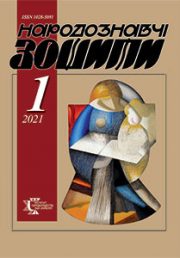The Ethnology Notebooks. 2019, № 5 (149), 1268—1273
UDK 398.2(477)161.2
DOI https://doi.org/10.15407/nz2019.05.1268
HORROR AND AMORRALITY IN «TALES OF POKUTTIA» BY OSCAR KOLBERG
HALAICHUK Oksana
ORCID ID: https://orcid.org/0000-0001-8052-6616
Ph.D. of Sciences in Philology.
Researcher of the International Institute
for Education, Culture and Diaspora Relations
of Lviv Polytechnic National University
32, Stepana Bandery street, 79000, Lviv, Ukraine
e-mail: ok_halaychuk@ukr.net
Abstract. In 1991, the publishing house «Carpathians» published tales translated in Cyrillic, which was recorded in the second half of the 19th century by the famous Polish ethnographer and folklorist Oscar Kolberg in Pokuttia. In the section «Fairy tales» our attention was drawn by the note that fairy tales № 2 and № 49 are not printed for ethical reasons. Research interest forced us to go to the source and find out that the reasons for which the texts of the fairy tales were not published were phenomena that cause the listener to experience a sense of horror and disgust, namely: blasphemy, deceit, incest, pregnancy termination, bestiality, murder, etc.
All other published «Tales of Pokuttya» contain mentions of no less immoral phenomena: fatherhood, child molestation, conscious mutilation, mutilation, incest, cannibalism, bestiality, etc. Excessive naturalistic detailing of these phenomena is terrifying and at once even in an adult, they sometimes find it difficult to find even a hint of didactics or aesthetics, which are the main genre-distinguishing factors of fairy-tale prose. So the question is, could the genre of the adult fairy tale (aimed at frightening, consciously hyperbolized, told for the purpose of entertaining, informing, warning or preventing such) exist in parallel with the children’s (moral-educational) fairy tale?
The article also compares the above-mentioned immoral phenomena with similar ones in Polish folk tales and stories. The author tries to answer the question of whether such fairy tales can be considered fairy tales in their traditional sense. Probably, it could be a separate genre of stories for adults, who were told to intimidate, cause terror, fear, and warn against unworthy acts. It is suggested to include them into the category of fairy tales for adults, so-called horror stories.
Keywords: fairy tale, horror, parricide, infanticide, mutilation, incest, cannibalism, bestiality.
Received 3.10.2019
REFERENCES
Kolberg, O. (1991). Tales of Pocuttia. Uzhorod: Karpaty [in Ukrainian].
The Origional Folk and Fairy Tales of the Brothers Grimm. The Complete First Edition Jacob & Wilhelm Grimm. Retrieved from: https://press.princeton.edu/titles/10300.html (Last accessed: 10.08.2019) [in English].
The Origional Folk and Fairy Tales of the Brothers Grimm. The Complete First Edition Jacob & Wilhelm Grimm (2015). Princeton: Princeton University Press [in English].
Schetkina, E. Us the old tales blur the line between good and evil. Retrieved from: http://www.dsnews.ua/society/yak-stari-kazki-zanovo-stirayut-mezhu-mizh-dobrom-ta-zlom-12112014202800 (Last accessed: 10.08.2019) [in Ukrainian].
Vrуblewska, V. (2018). Dictionary of Polish folk tales. (Vol. 1: a—e). Toruс: Nicolaus Copernicus University [in Polish].
Vrуblewska, V. (2018). Dictionary of Polish folk tales. (Vol. 2: f—o). Toruс: Nicolaus Copernicus University [in Polish].
Vrуblewska, V. (2018). Dictionary of Polish folk tales. (Vol. 2: p—z). Toruс: Nicolaus Copernicus University [in Polish].
Mushketyk, L. (2014). Characters of Ukrainian folk tales. Kyiv: Ukrainsґkyj pysґmennyk [in Ukrainian].
Propp, V. (1998). Morphology of magical tales. Historical roots of magical tales. Moscow: Labirint [in Russian].
Kolberg, O. (1889). Pocuttia: Ethnographic review (Vol. 4). Krakow [in Polish].






